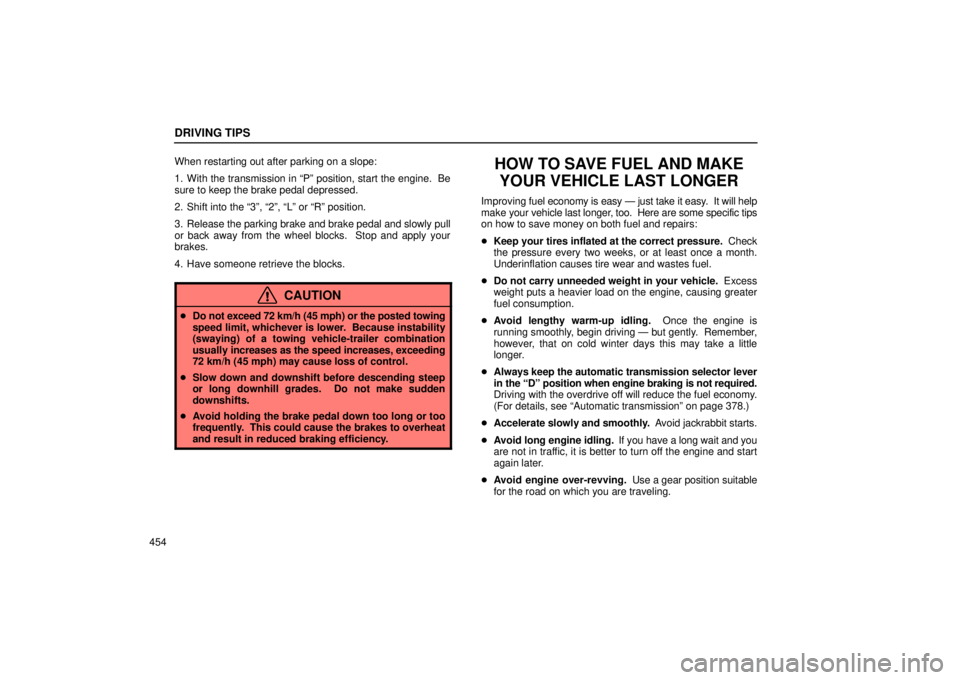Page 481 of 656

DRIVING TIPS
453
�
Avoid jerky starts or sudden acceleration.
� Avoid jerky steering and sharp turns. The trailer could hit
your vehicle in a tight turn. Slow down before making a turn
to avoid the need of sudden braking.
� Remember that when making a turn, the trailer wheels will
be closer than the vehicle wheels to the inside of the turn.
Therefore, compensate for this by making a larger than
normal turning radius with your vehicle.
� Crosswinds and rough roads will adversely affect handling
of your vehicle and trailer, causing sway. Pay attention to
the rear from time to time to prepare yourself for being
passed by large trucks or buses, which may cause your
vehicle and trailer to sway. If swaying happens, firmly grip
the steering wheel and reduce speed immediately but
gradually. Never increase speed. If it is necessary to
reduce speed, brake slowly. Steer straight ahead. If you
make no extreme correction with the steering or brakes,
your vehicle and trailer will stabilize.
� Be careful when passing other vehicles. Passing requires
considerable distance. After passing a vehicle, do not forget
the length of your trailer and be sure you have plenty of room
before changing lanes.
� In order to maintain efficient engine braking and electrical
charging performance, do not use overdrive. Transmission
must be 4º position. �
Because of the added load of the trailer, your vehicle's
engine may overheat on hot days (at temperatures over
30�C [85 �F]) when going up a long or steep grade with a
trailer. If the engine coolant temperature gauge indicates
overheating, immediately turn off the air conditioning (if in
use), pull your vehicle off the road and stop in a safe spot.
See If your vehicle overheatsº on page 468.
� Always place wheel blocks under both the vehicle and trailer
wheels when parking. Apply the parking brake firmly. Put
the transmission in Pº. Avoid parking on a slope with a
trailer, but if it cannot be avoided, do so only after performing
the following:
1. Apply the brakes and keep them applied.
2. Have someone place wheel blocks under both the vehicle
and trailer wheels.
3. When the wheel blocks are in place, release your brakes
slowly until the blocks absorb the load.
4. Apply the parking brake firmly.
5. Shift into Pº and turn off the engine.
Page 482 of 656

DRIVING TIPS
454When restarting out after parking on a slope:
1. With the transmission in Pº position, start the engine. Be
sure to keep the brake pedal depressed.
2. Shift into the 3º, 2º, Lº or Rº position.
3. Release the parking brake and brake pedal and slowly pull
or back away from the wheel blocks. Stop and apply your
brakes.
4. Have someone retrieve the blocks.
CAUTION
�
Do not exceed 72 km/h (45 mph) or the posted towing
speed limit, whichever is lower. Because instability
(swaying) of a towing vehicle-trailer combination
usually increases as the speed increases, exceeding
72 km/h (45 mph) may cause loss of control.
� Slow down and downshift before descending steep
or long downhill grades. Do not make sudden
downshifts.
� Avoid holding the brake pedal down too long or too
frequently. This could cause the brakes to overheat
and result in reduced braking efficiency.
HOW TO SAVE FUEL AND MAKE
YOUR VEHICLE LAST LONGER
Improving fuel economy is easy Ð just take it easy. It will help
make your vehicle last longer, too. Here are some specific tips
on how to save money on both fuel and repairs:
� Keep your tires inflated at the correct pressure. Check
the pressure every two weeks, or at least once a month.
Underinflation causes tire wear and wastes fuel.
� Do not carry unneeded weight in your vehicle. Excess
weight puts a heavier load on the engine, causing greater
fuel consumption.
� Avoid lengthy warm-up idling. Once the engine is
running smoothly, begin driving Ð but gently. Remember,
however, that on cold winter days this may take a little
longer.
� Always keep the automatic transmission selector lever
in the Dº position when engine braking is not required.
Driving with the overdrive off will reduce the fuel economy.
(For details, see Automatic transmissionº on page 378.)
� Accelerate slowly and smoothly. Avoid jackrabbit starts.
� Avoid long engine idling. If you have a long wait and you
are not in traffic, it is better to turn off the engine and start
again later.
� Avoid engine over-revving. Use a gear position suitable
for the road on which you are traveling.
Page 605 of 656
CHASSIS
577
Tire chain selection
� 1 Side chain2 Cross chain
Use the tire chains of correct size.
For P265/65R17 tires, use the following type chains.
mm (in.)
A: Diameter of side chain 5.0 (0.20)
B: Width of side chain 18.0 (0.71)
C: Length of side chain 46.0 (1.81)
D: Width of cross chain 22.6 (0.89)
E: Length of cross chain 38.1 (1.5)
F: Diameter of cross chain 6.3 (0.25) Regulations regarding the use of tire chains vary
according to
location or type of road. Always check local
regulations before installing chains.
Page 636 of 656
BODY
608
SPECIFICATIONS
Ð DIMENSIONS AND WEIGHTSOverall length
4780 mm (188.2 in.)
Overall width1880 mm (74.0 in.)
Overall height*11855 mm (73.0 in.)*2
1895 mm (74.6 in.)*3
Wheelbase2790 mm (109.8 in.)
Tread Ð Front Ð Rear1585 mm (62.4 in.)
1585 mm (62.4 in.)
Vehicle capacity weight
(occupants + luggage)
With third seats
Without third seats
544 kg (1200 lb.)
454 kg (1000 lb.)
Towing capacity
(vehicles without kinetic dynamic
suspension system)For weight carrying hitch
Also for weight distributing hitch
2268 kg (5000 lb.)
2948 kg (6500 lb.)
*1: Unladen vehicle
*2: Without roof luggage carrier
*3: With roof luggage carrier